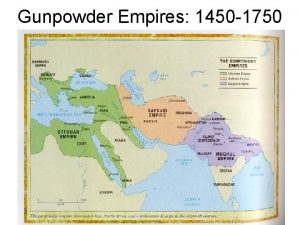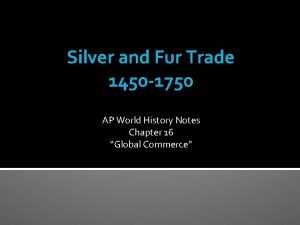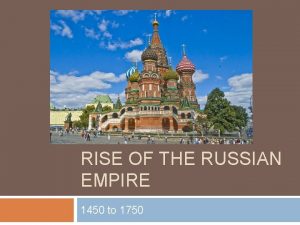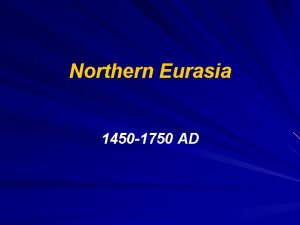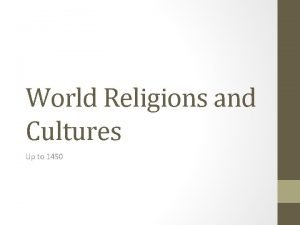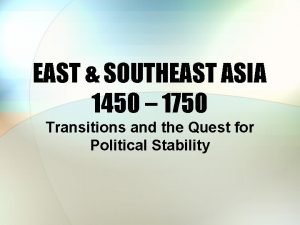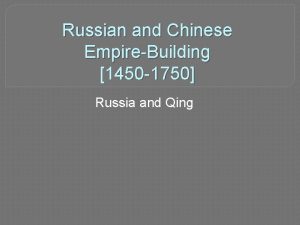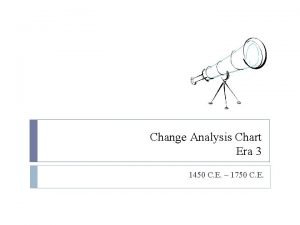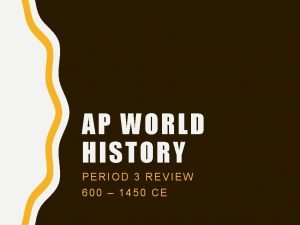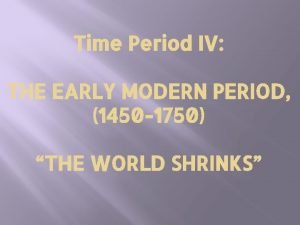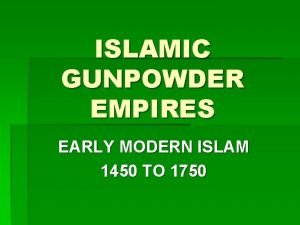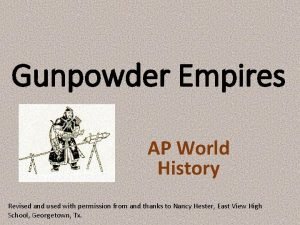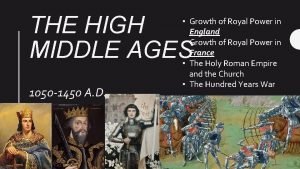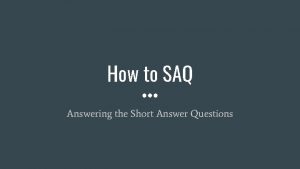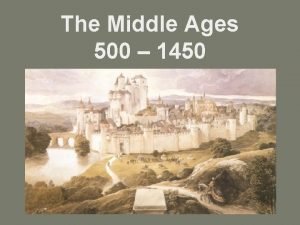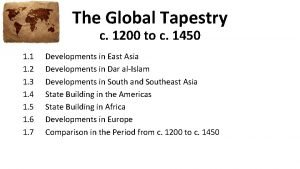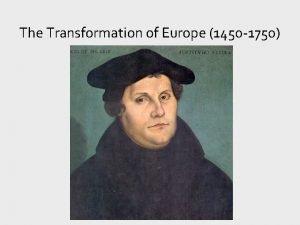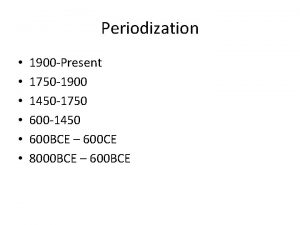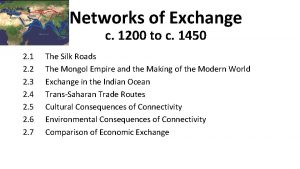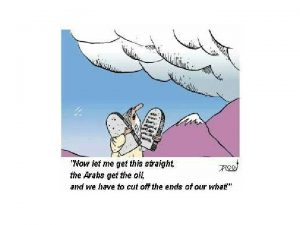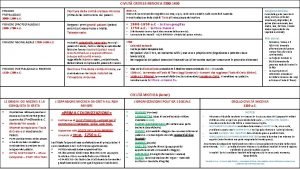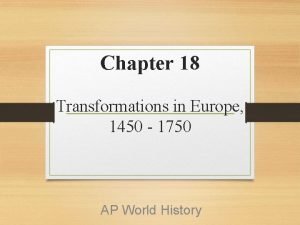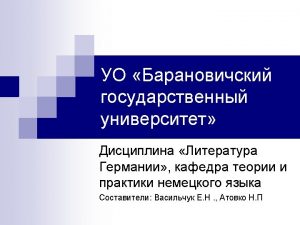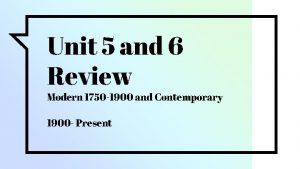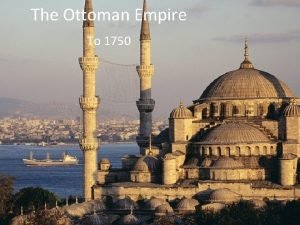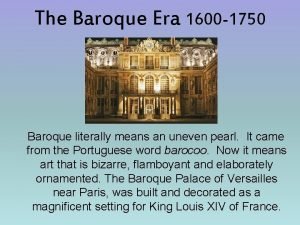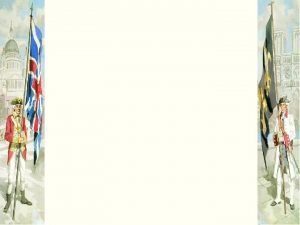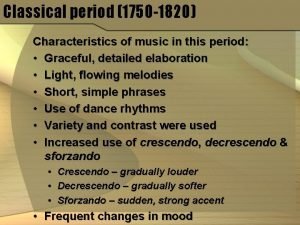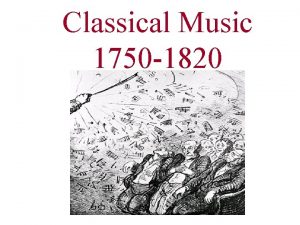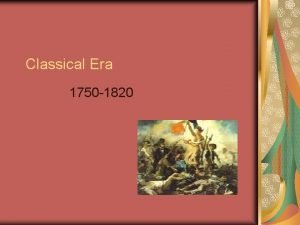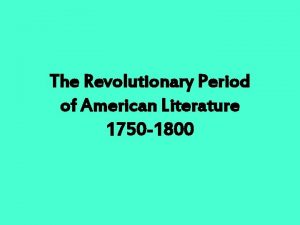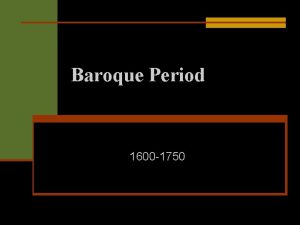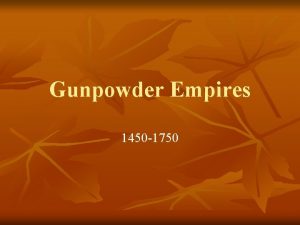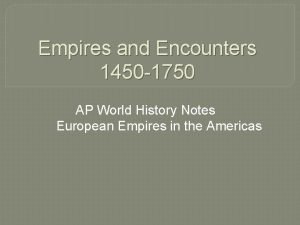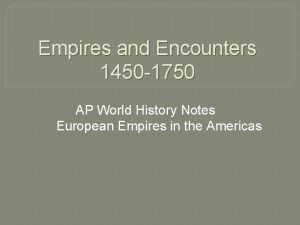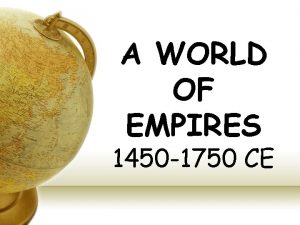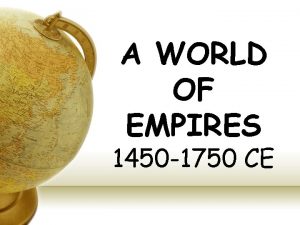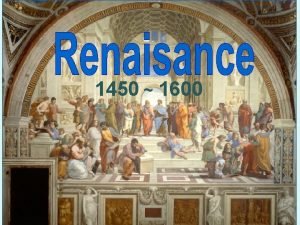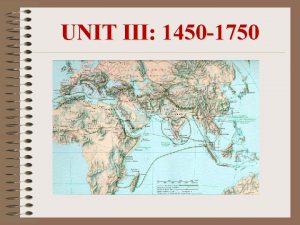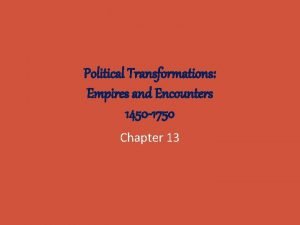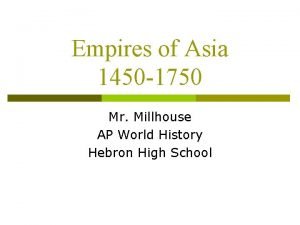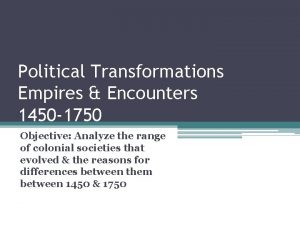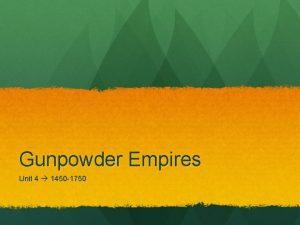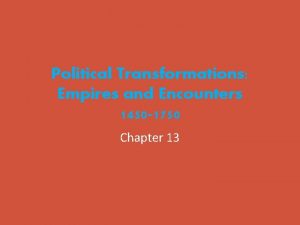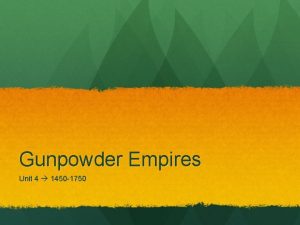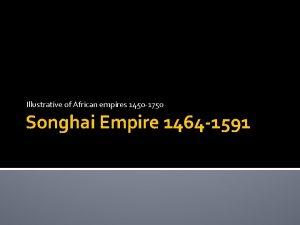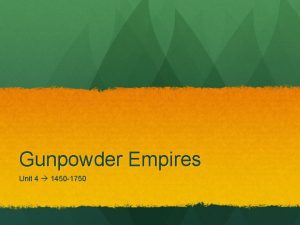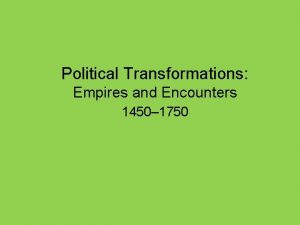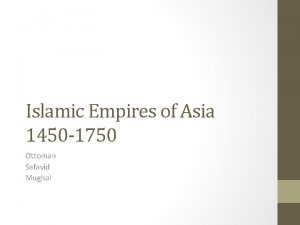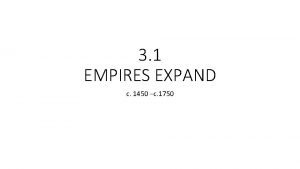A WORLD OF EMPIRES 1450 1750 CE Content













































- Slides: 45

A WORLD OF EMPIRES 1450 -1750 CE


Content and non-content specific vocabulary on tomorrow’s test 1450 -1750 Content Specific Non-content specific Commodities atheism Bureaucracy syncretic Mercantilism Mullatoe, Mestizo, Peninsulares, Creole Sovereignty Mita Census Amerindian Monetary systems Folklore Baptisms Demographic Basin( relating to maritime location) Scarcer Nahuatl Encomienda Jesuits and Franciscans Mexica Oceania Artillery Industrial manufacturing Pandemics Cash crops Missionizing religions Account books Textile mills Serfs Plantation labor Shia Islam Human migration Homily Clergy Filial submission Profound Destabilization Elite Peripheral Core Cargoes Maladies Proportional Indigenous Supplanted Integration Spurred Catalyzed Contention Influx synthesis Enclaves Avenge Influx Livestock Impetus Ventures Trends Intersection Challenge Collaborator Transfer Evident Disobedient Bearers Abrupt Piecemeal reverence infallibly capricious modesty adherents assertion








Americas 1300 -1800 • Rise of Incas • Continued rise of Aztecs • Conquest – arrival of Spanish in western hemisphere • Population impacts: disease, racial intermingling, war • Columbian exchange • Colonial societies

Inca Empire— 1438 -1525 • • Highly centralized government Diverse ethnic groups Extensive irrigation State religion/ancestor cult Rope suspension bridges Metallurgy – copper and bronze No use of wheel Roads for tax, labor, and courier system

Aztec Empire 1325 -1520 • Tenochtitlan “Foundation of Heaven” • By 1519, metropolis of 150. 000 -five square miles • Island location • Tribute empire based on agriculture • State control of market – redistributes all goods

Changes in Trade, Technology and Global Interactions • Exploration • Gold, Glory and God? • Commodities • Cartography • Empire Building

Age of Exploration • European exploration Why then? Why? Who and where? • End of Ming Treasure / Tribute Voyages Zheng He

Commodities • African slave trade Notice the primary destinations

Commodities • Coffee beans used first in Yemen and then later in Europe and Americas • European used chocolate technology from Aztecs in 17 th Century

Cartographic Changes

Empire Building: Fortunes won and lost (Players and haters in a finite economy) • Silver impacts: • • • Potosi, Bolivia becomes largest city in Americas because of valuable silver mines. Native labor under horrendous conditions. Spanish Empire initially becomes a booming economy (pieces of eight widely used” in international trade, eventually lack of Spanish investment by aristocracy inflation grow ( as silver falls so too does the Spanish economy) Japan’s Tokugawa Shogunate profits greatly re-investing in the agriculture and industry consolidating its authority in Edo (centralized feudalism) and limiting port trade to Nagasaki, China’s Ming Dynasty forces ports in Canton and Macao open to new commercial interest so that Chinese can acquire silver ( since it was the only way to pay taxes) China becomes a silver sink, glutting the market and devaluing silver in the 17 th century Who would be the missing voice? New Bourgeoisie middle class serving as European “middle men” in luxury trade? Native mita laborers in mines in Potosi, Acapulco, or Bahia? Japanese mine owners looking to profit off of silver trade? Manila Galleon shippers looking to gain access to ports in Canton or Macao?

Africa • Characteristics: • Stateless societies-organized around kinship, often larger than states, forms of government • Large centralized states–increased unity came from linguistic base–Bantu, Christianity and Islam, as well as indigenous beliefs • Trade–markets, international commerce, taxed trade of unprocessed goods.

African Empires • Oyo • Benin • Kongo • Asante

Songhay • Initially farmers, herders, and fishers • Foreign merchant community in Goa (gold) • Powerful cavalry forces, expansive empire (1492) • Fusion of Islamic and indigenous traditions

Ottoman 1281 -1914 • 1350’s – Initial Ottoman invasion of Europe • 1453 – Ottoman capture of Constantinople • 1683 – Ottoman siege of Vienna

Ming China 1368 -1644 Manchu Qing Dynasty 1644 -1912

Japan

Tokugawa Japan 1600 -1853 • Cultural borrowing from China • Emergence of warrior class and increasing civil wars • Encounter with Portuguese-1543 • “Isolation” from West; rise of Tokugawas • Tokugawa elite followed development in West (contrast to China’s “hairy barbarian” mentality)

Mughal India 1556 -1739 • Empire based on military strength • Akbar the Great–-combined beliefs into new religion to unite Hindu and Muslim subjects: Din-I-Ilahi • Indian textile trade–value to Europeans • Patron of the arts— Shah Jahan

Safavid Persia 1334 -1722

Empires: Russia • Mongol occupation stalled Russian unification and development • Increasing absolutist rule and territorial expansion by 16 th Century – Ivan the Terrible • Role of Russian Orthodox Church • Peter the Great accelerated westernization process

Fur Trade – French, British, Native Peoples, Russians

Portugal • Search for maritime route to Asia • Naval school • Advanced naval technology: caravels, carracks, astrolabe and compass

Portugal • Established fortresses along the Gold Coast – sugar plantations and African slave labor • Indian Ocean trade and Da Gama: Malindi, Sofala and Kilwa, Calicut and Goa, and later Macao • Atlantic trade with conquest of Brazil – sugar plantation

Brazil: Plantation colony • Portuguese due to Treaty of Tordesillas 1494 • African slave labor used to support plantation complex (sugar) • Largest producer of sugar in world first half of 17 th C.

Spain • Reconquista ended with fall of Granada • Inquisition • Columbus’ voyage • Cortez in Mexico and Pizarro in Peru • Took over existing tributary empires: labor, silver, gold, and foodstuffs • Demographic impact: disease, death, and mestizos

England • • • Limited/constitutional monarchy Civil Wars Commonwealth Charles II James II Glorious Revolution Bill of Rights • Enlightenment ideas • Colonies in Americas

France • Absolute Monarchy King Louis XIV “ I am the State” Versailles • Mercantilism • Territorial expansion in Europe and fur-trading colonies in Saint Domingue (Haiti) and New France (Quebec)

Dutch • Dutch East India Company • 1660—employed 12, 000 people with 257 ships • Sought monopolies and large profits • North America (fur trade-Hudson River, New Amsterdam) • Caribbean islands for plantations • Capetown, South Africa – way station • Southeast Asia – spice trade (nutmeg, cloves and pepper)

Gender and Empire • How might colonial conquests influence gender roles?

Changing Beliefs • Reformation • Neo-Confucianism • Missionaries: Christianity, Islam, Buddhism

Missionaries: Jesuits

Cultural and Intellectual Development • Scientific Revolution • Enlightenment • Patronage of the arts

Demographic and Environmental Changes • Predict what the consequences of increased integration and empire building be on population? On the environment? Think long and short term.

Comparisons Be able to compare the following: • Imperial systems: European monarchy vs. a land-based Asian empire • Coercive labor systems • Empire building in Asia, Africa and Europe • Russia’s interaction with the West compared to others

Conclusions • What are the major themes that seem apparent? • What global processes are in action?

A WORLD OF EMPIRES 1450 -1750 CE
 Land based empires 1450 to 1750
Land based empires 1450 to 1750 Mughal empire 1450 to 1750
Mughal empire 1450 to 1750 Silver trade 1450 to 1750
Silver trade 1450 to 1750 Russian empire architecture 1450 to 1750
Russian empire architecture 1450 to 1750 Japan 1450-1750
Japan 1450-1750 Religion 1450-1750
Religion 1450-1750 Southeast asia 1450 to 1750
Southeast asia 1450 to 1750 St basil's cathedral ap world history
St basil's cathedral ap world history Change analysis chart 1450 to 1750
Change analysis chart 1450 to 1750 Land empires vs maritime empire
Land empires vs maritime empire Ap world history 600 to 1450 review
Ap world history 600 to 1450 review World map 1450
World map 1450 Gunpowder empires definition ap world history
Gunpowder empires definition ap world history Gunpowder ap world history
Gunpowder ap world history Characteristics of esp
Characteristics of esp Static content vs dynamic content
Static content vs dynamic content 1450 ad
1450 ad Kznu radio
Kznu radio Saq answer example
Saq answer example 500/1450
500/1450 C-1450-1
C-1450-1 Europe 1450
Europe 1450 1900-1450
1900-1450 C-1450-2
C-1450-2 1450-1250
1450-1250 2300-1450
2300-1450 Europe 1450
Europe 1450 Toreador fresco meaning
Toreador fresco meaning Renaissance historical events
Renaissance historical events Poetischer realismus historischer hintergrund
Poetischer realismus historischer hintergrund 1750-1900 portfolio map
1750-1900 portfolio map 1750 ottoman empire
1750 ottoman empire 1750-1825
1750-1825 It is an era from 1750-1820
It is an era from 1750-1820 1750 means
1750 means Map of north america 1763
Map of north america 1763 Neoclassical
Neoclassical Classical music has less complicated texture
Classical music has less complicated texture Jonathan sebastian bach
Jonathan sebastian bach 1685 1750
1685 1750 Music of the classical period (1750 to 1820)
Music of the classical period (1750 to 1820) 1750 to 1820 classical music
1750 to 1820 classical music 1820-1750
1820-1750 Dynamics of baroque music
Dynamics of baroque music American literature revolutionary period
American literature revolutionary period Buxtehude composer
Buxtehude composer
